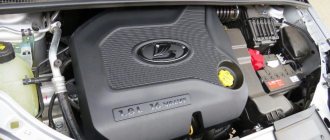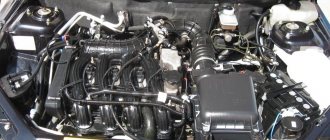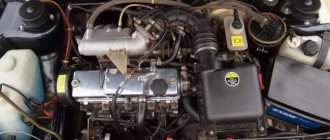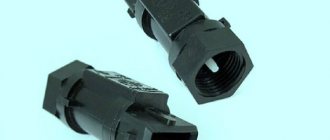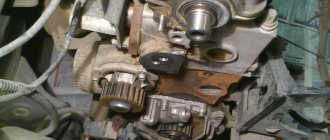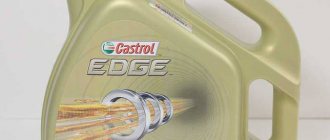Technical characteristics of the VAZ 2110,2111, 2112 engine
The engine was installed on such popular AvtoVAZ models as VAZ-2110, VAZ-2111 and VAZ-2112.
- Displacement - 1499 cc.
- Number of cylinders - 4 pcs.
- Number of valves - 16 pcs.
- Maximum power - 93 hp/5600 rpm.
- Maximum torque - 128 Nm/3700 rpm.
- Maximum engine power is 93 hp.
- Compression ratio – 10.5
- Gasoline octane number - 95
- Environmental standards - Euro 3
- Acceleration 0 - 100 km/h - 11.9 seconds.
- Combined cycle consumption - 7.2 L/100 km
- Engine life - 200 - 250 thousand km.
- Valves - oppression
Problems
Despite all the positive qualities, the power unit received a fairly large number of common problems. But despite the rather short time period since its production, they have already made themselves felt:
- Adjusting the valves of the VAZ 11182 engine is no longer a classic task, since the design has been changed, and now the washers are no longer needed, but the pusher will have to be changed. This is a fairly expensive task that you will have to deal with quite often.
- Sensors Despite the fact that the power unit has been somewhat redesigned and almost all problem areas have been eliminated, the quality of the components still leaves much to be desired. Most sensors fail very often.
- Oil leak. The gaskets used in the design of the power unit are also made of low-quality materials, so it is not uncommon that even on relatively new engines you may encounter the problem of oil or antifreeze leakage.
- Ignition system. Coils and spark plugs also have a fairly large number of negative reviews, so if the car starts to stall, then you should pay attention to the elements of this system. As a rule, the coils fail.
Technical characteristics of the VAZ 21114 and 11183 engine
The engine was installed on such popular AvtoVAZ models as Lada Kalina, VAZ 2108, 21083, 2109, 21093, 21099, 2113, 2114, 2115, 2110, 2111, 2112.
- Displacement - 1596 cc.
- Number of cylinders - 4 pcs.
- Number of valves - 8 pcs.
- Maximum power - 81 hp / 5200 rpm.
- Maximum torque - 125 Nm/3000 rpm.
- Maximum engine power - 81 hp.
- Compression ratio – 9.6
- Gasoline octane number - 92.95
- Environmental standards - Euro 2,3,4
- Acceleration 0 - 100 km/h - 12.9 seconds.
- Combined cycle consumption - 7.6 L/100 km
- Engine life - 150 - 250 thousand km.
- Valve - no bending
What engines was equipped with the VAZ 2107
"Seven" was produced for a very long time - from 1972 to 2012. Of course, during this period, the vehicle’s configurations and equipment changed and were modernized. But initially (in the 1970s) the VAZ 2107 was equipped with only two types of engines:
- From its predecessor 2103 - a 1.5 liter engine.
- From 2106 - 1.6 liter engine.
On some models, more compact 1.2 and 1.3 liters were also installed, but such cars were not widely sold, so we will not talk about them. The most traditional for the VAZ 2107 is a 1.5 liter carburetor engine. Only later models began to be equipped with 1.5 and 1.7 liter injection engines.
Moreover, a number of rear-wheel drive VAZ 2107 exhibits were equipped with front-wheel drive engines, but the designers immediately abandoned such an idea - it was too labor-intensive and unjustified.
Technical characteristics of the VAZ 21116 and 11186 engine
The engine was installed on such popular AvtoVAZ models as Lada Granta, Lada Kalina 2.
- Displacement - 1596 cc.
- Number of cylinders - 4 pcs.
- Number of valves - 8 pcs.
- Maximum power - 87 hp/5100 rpm.
- Maximum torque - 140 Nm/3800 rpm.
- Maximum engine power - 87 hp.
- Compression ratio – 10.5
- Gasoline octane number - 95
- Environmental standards - Euro 4
- Acceleration 0 - 100 km/h - 10.9 seconds.
- Combined cycle consumption - 7.2 L/100 km
- Engine life - 200 - 250 thousand km.
- Valve - no bending
Maintenance
Reviews from car owners about the VAZ 11182 engine indicate that timely maintenance is required to increase the life of the power unit. Once every 15 thousand kilometers it is necessary to change the engine oil, but with an engine capacity of 4.5 liters, about 4.1 liters will be required to change it.
The declared resource of the timing belt is about 160 thousand kilometers, but it is worth contacting a service center to replace it after 100 thousand kilometers. It is clear that almost no one does this, since the clan is not oppressed, but not everyone wants trouble to meet them on the road.
Technical characteristics of the VAZ 21214 engine
The engine was installed on such popular AvtoVAZ models as Chevrolet Niva and LADA 4×4.
- Working volume - 1690 cc.
- Number of cylinders - 4 pcs.
- Number of valves - 8 pcs.
- Maximum power - 81 hp/5200 rpm.
- Maximum torque - 125 Nm/3000 rpm.
- Maximum engine power - 81 hp.
- Compression ratio – 9.4
- Octane number of gasoline - 92.95
- Environmental standards - Euro 4
- Acceleration 0 - 100 km/h - 12.9 seconds.
- Combined cycle consumption - 10.5 L/100 km
- Engine life - 100 - 150 thousand km.
- Valve - no bending
Advantages
From the very beginning of sales, it became clear that this power unit is particularly reliable and evokes quite positive reviews from owners of cars with it under the hood. The main advantages that were noted over such a short service life of the power unit are the following:
- Despite the fact that the service life of the VAZ 11182 engine, according to manufacturers, is about 150 thousand kilometers, the engine has already covered more than this figure in many cases. If the engine is properly maintained, it can travel more than 300 thousand kilometers.
- Many people wonder whether the VAZ 11182 engine bends the valves. And this is its main advantage over its predecessor, since if the timing belt breaks, the pistons do not contact the valves.
- Potential for tuning. Manufacturers have built a large margin of safety into the elements of the power unit, so there is huge potential to increase its power. Even without the need to replace power elements, the motor will operate without compromising its service life.
Technical characteristics of the VAZ 21124 engine
The engine was installed on such popular AvtoVAZ models as VAZ-2110, VAZ-2111 and VAZ-2112.
- Displacement - 1599 cc.
- Number of cylinders - 4 pcs.
- Number of valves - 16 pcs.
- Maximum power - 89 hp/5000 rpm.
- Maximum torque - 131 Nm/3700 rpm.
- Maximum engine power is 89 hp.
- Compression ratio – 10.3
- Gasoline octane number - 95
- Environmental standards - Euro 4
- Acceleration 0 - 100 km/h - 10.7 seconds.
- Combined cycle consumption - 7.5 L/100 km
- Engine life - 200 - 250 thousand km.
- Valve - no bending
Interesting on the site: VAZ 2107 injector
Motor 2101 “Kopeyka”
It’s no secret that the first “Kopeyka” is a prototype of the Italian FIAT 124.
Accordingly, the first of the VAZ engines was initially only a modification of its predecessor, a kind of tuning of the VAZ engine.
The characteristics of VAZ engines have been changed:
- Thanks to the transfer of the camshaft from the lower to the upper part, an increase in the cylinder diameter by 3 mm, and a decrease in the piston stroke by 5.5 mm, the unit became more throttle response due to its transformation into a “short-stroke” one. The speed picked up faster, and throttle response began to be felt more strongly with sudden changes in the accelerator position.
- The only drawback of the engine at that time, which received the marking 2101, was the increase in noise.
- 4 years later, after the modification of “Kopeyka” 21011, a modernized VAZ engine of the same name appeared with markings identical to the model number. It began to differ from its recent ancestor in the following indicators: the VAZ engine displacement increased from 1200 to 1300 cm3, the cylinder diameter increased by another 3 mm, and the power increased by 3 “horses”. This VAZ engine was installed on both 01 series models and subsequent 2102 models.
- Carburetors for these engines were produced in 3 series until 1978, and later the Ozone 2105 appeared, which acquired an autonomous idle system, slightly changing the technical characteristics of the VAZ engine. These carburetors became much more practical, the car started easier in cold weather, and the quality of the fuel was less reflected in idling and sharp pressure on the accelerator.
Further tuning of the VAZ engine consisted of strengthening the transmission, which Italian engineers liked, and later they began to use Soviet modifications on their units.
Later, exports began to spread, and for the first time a rotary engine in a VAZ appeared on cars sent to neighboring countries.
This was the first successful experiment, but due to the difficulty of repairing such a unit and the virtual lack of spare parts, over time these types of motors became unpopular. Although analysts predicted a good future for units of this type, it was only necessary to properly establish the spare parts market.
Technical characteristics of the VAZ 21126 engine
The engine was installed on such popular AvtoVAZ models as Priora, Granta, Kalina 2.
- Displacement - 1597 cc.
- Number of cylinders - 4 pcs.
- Number of valves - 16 pcs.
- Maximum power - 98 hp/5600 rpm.
- Maximum torque - 145 Nm/4000 rpm.
- Maximum engine power is 98 hp.
- Compression ratio – 11
- Gasoline octane number - 95
- Environmental standards - Euro 4
- Acceleration 0 - 100 km/h - 10.1 seconds.
- Combined cycle consumption - 7.2 L/100 km
- Engine life - 200 - 300 thousand km.
- Valves - oppression
Valve adjustment will become more difficult
Previously, adjusting valves required only removing the valve cover, some simple skill, and a set of shims that many owners had accumulated over decades. Now, to adjust the gaps, you will have to raise the camshaft, measure the cups (pushers) and buy new ones for about a thousand apiece. Therefore, it is more profitable to contact the service. Moreover, the gaps will now have to be adjusted less frequently - only every 90,000 km.
A one-piece valve lifter instead of the previous shim design is a step forward. But this step will complicate maintenance for the consumer at high mileage.
A one-piece valve lifter instead of the previous shim design is a step forward. But this step will complicate maintenance for the consumer at high mileage.
Technical characteristics of the VAZ 21128 engine
The engine was installed on such popular AvtoVAZ models as VAZ 21104, Lada 2112 Coupe 1.8, Lada Priora 1.8
- Working volume - 1796 cc.
- Number of cylinders - 4 pcs.
- Number of valves - 16 pcs.
- Maximum power - 98 hp. /5200 rpm
- Maximum torque - 162 Nm/3200 rpm.
- Maximum engine power is 98 hp.
- Compression ratio – 10.5
- Gasoline octane number - 95
- Environmental standards - Euro 4
- Acceleration 0 - 100 km/h - 9.8 seconds.
- Combined cycle consumption - 7.5 L/100 km
- Engine life - 100 - 150 thousand km.
- Valves - oppression
There is also an interesting article on the site about the boxer engine
What kind of engine can be installed on the “seven” instead of the standard one?
The driver begins to think about changing the engine when, for some reason, he is no longer satisfied with the operation of the standard equipment. In general, the 2107 model is excellent for various kinds of technical experiments and tuning, but the rational approach to choosing new equipment has not yet been canceled.
Therefore, before you even think about a new motor for your swallow, you need to weigh the pros and cons, namely:
- what goals need to be achieved when replacing a standard engine;
- are there technical capabilities to safely connect the motor;
- Is it possible to do the replacement yourself, etc.
Engines from other VAZ models
Naturally, engines from cars of the same family can be installed on the VAZ 2107i without significant modifications and loss of time. Experienced car enthusiasts advise taking a closer look at engines from:
- VAZ 2114;
- "Lada Niva";
- "Lada Priora".
These are more modern power units with an increased number of “horses”. In addition, the engine dimensions and connection connectors are almost identical to the standard equipment of the “Seven”.
Engines from foreign cars
Imported engines are rightfully considered more reliable and durable, so the idea of installing a foreign-made engine in a VAZ 2107i often excites the minds of drivers. It must be said that this idea is quite feasible if we take Nissan and Fiat models from 1975–1990 as donors.
The thing is that Fiat became the prototype of the domestic Zhiguli, so structurally they have a lot in common. And Nissan is also technically similar to Fiat. Therefore, without significant modifications, you can install engines from these foreign cars on the VAZ 2107.
Nissan Silvia is an excellent donor for the VAZ 2107i, since the procedure for replacing engines is possible without the involvement of service station specialists
Rotary power units
On "sevens" rotary engines are not that uncommon. In fact, due to the specifics of their work, rotor mechanisms can significantly optimize the operation of the VAZ 2107i and give the car acceleration and power.
An economical rotary engine ideal for the 2107 is a modification of the RPD 413i. The 1.3-liter unit develops power up to 245 horsepower. The only thing the driver should know about in advance is the drawback of the RPD 413i - a service life of 75 thousand kilometers.
A very powerful rotary engine will make any “seven” fly
Today, the VAZ 2107i is no longer produced. At one time it was a good car at an affordable cost for living and working. The injection modification of the “Seven” is considered to be maximally adapted to Russian operating conditions; moreover, the car is easily amenable to various kinds of under-hood upgrades and alterations.
Technical characteristics of the Lada Granta Sport 120 hp engine.
- Displacement - 1597 cc.
- Number of cylinders - 4 pcs.
- Number of valves - 16 pcs.
- Maximum power - 118 hp/5900 rpm.
- Maximum torque - 154 Nm/4740 rpm.
- Maximum engine power is 118 hp.
- Compression ratio – 11
- Gasoline octane number - 95
- Environmental standards - Euro 4
- Acceleration 0 - 100 km/h - 9.3 seconds.
- Combined cycle consumption - 7.8 L/100 km
- Engine life - 250 - 300 thousand km.
- Valves - oppression
Miscalculations of marketers
A significant part of car owners are skeptical about engines with a power slightly exceeding a hundred “horses”: the output of such engines is quite modest, and the tax coefficients are higher. This affects the decline in popularity of the 21127 series engines.
These VAZ engines were competitive only at the time of their creation, and this was in the eighties of the last century. Now, without having time to get rid of congenital defects, they are irrevocably outdated. It is for this reason that AvtoVAZ would do well to take a closer look at another engine base: whether it is its own development or a licensed unit does not matter, but the new engine needs to be introduced as quickly as possible, before electric motors outlive conventional internal combustion engines.
Technical characteristics of the VAZ 21129 engine
The engine is installed on such popular AvtoVAZ models as the VAZ 2180
- Displacement - 1599 cc.
- Number of cylinders - 4 pcs.
- Number of valves - 16 pcs.
- Maximum power - 106 hp. /4800 rpm
- Maximum torque - 148 Nm/4000 rpm.
- Maximum engine power - 106 hp.
- Compression ratio – 11
- Gasoline octane number - 95
- Environmental standards - Euro 4
- Acceleration 0 - 100 km/h - 9.6 seconds.
- Combined cycle consumption - 7.2 L/100 km
- Engine life is 250 thousand km.
- Valves - oppression
Where is the engine number
The engine number is unique to each vehicle. This is a kind of model identification code. On injection-powered "sevens" this code is stamped out and can be located only in two places under the hood (depending on the year of manufacture of the car):
- on the bottom shelf of the air supply box on the right;
- on the cylinder block.
All designations within the engine number must be clearly readable and not cause double interpretation.
When purchasing a new car, it is important that all license plates are readable and free from scuffs or signs of counterfeiting.
Reliability, weaknesses, maintainability
Reliability
Due to the short service life, there is no specific data on engine reliability yet. But according to the manufacturer’s forecasts, the VAZ-11182 is considered the most successful option among all VAZ 8-valve engines. Accordingly, the new motor is positioned as quite reliable.
The development of new, “stickless” pistons has significantly raised the spirits of car owners of this internal combustion engine. Gone are the nightmares about the possible consequences of a broken timing belt - bending of valves, destruction of the piston and expensive repairs.
The bearings and connecting rods are copied from the VAZ-21179 engine. The crankshaft is updated, but the connecting rod journal is identical to the crankshaft journal of the same 1.8-liter VAZ-21179. Here the priority was to reduce mechanical friction losses and increase reliability.
It is clear that the maximum loads of the 122-horsepower and 90-horsepower engines differ significantly from each other. Thus, the VAZ-11182 crankshaft contains an additional safety margin, which increases its reliability.
It is appropriate to note that more than 20 items of parts and components have been replaced on the engine. It is characteristic of the VAZ-11182 that all new changes in the mechanical part were made not by designed parts, but by previously used parts and assembly units that had already proven themselves in practice.
For example, valve stem seals are taken from the H4M engine (developed by Nissan, produced by AvtoVAZ). From the same engine, valve tappets and crackers are used.
The first reviews, or rather, discussions about the engine, appeared on the forums. So, StAndr writes: “... the pistons have become heavy with a good compression distance, the connecting rods are now centered on the crankshaft cheeks, and not on the piston bosses. The block is cast iron, not aluminum, like on foreign cars - it holds the geometry well. There are oil nozzles. The torque is not bad - 143 Nm, and from 1000 rpm 80% of the torque is available, i.e. 114 -115 Nm."
The changes made to the internal combustion engine of the VAZ-11182 allow us to hope that the engine will be highly reliable.
Weak spots
The engine has not yet had time to prove itself in operation, so there is no information about its weak points. But on the forums you can find scant data on this issue.
For example, one of the owners of the VAZ-11182, in all likelihood, had to deal with disassembling the engine. In his review, he noted that there was rough surface milling on the plane of the cylinder block. As a result, problems arose with oil and coolant leaking through the head gasket.
But such reports are rare, and it is too early to judge whether the error in block processing is a weak point.
Sometimes the engine shakes at idle speed. Replacing the spark plugs and adjusting the ignition mechanism eliminates this problem.
Some engines have increased oil consumption. Usually this problem occurs around 80-100 thousand kilometers. Oil intake can be about 900 grams. per 1000 km. The true reason for this phenomenon has not been clarified, but it is believed that the design feature of the CPG is to blame.
Maintainability
The maintainability of the unit is good. But it should be noted that the repair process itself is complex. You can't do this without experience and special tools. Forum member 46B writes: “...now you can’t adjust the valves in the garage, you have to disassemble half the engine, and the price of pushers is from 1,500 rubles. for 1 piece."
In general, there are no problems with finding spare parts. The only trouble is that you can run into a fake. The Chinese manufacturer is especially famous for counterfeit products.
Therefore, when restoring an engine, it is recommended to use only original components and parts.
The modern VAZ-11182 engine is a completely reliable and economical engine, but only if it is handled accordingly.
Description
The new VAZ-11182 engine was presented to the general public quite recently, in January 2022. He received his first registration for Lada Largus FL.
Later it became the basic modification for Largus van and station wagon models. In the spring, in May of the same year, VAZ-11182 began to be installed on the Lada Granta.
The engine is a four-cylinder in-line naturally aspirated petrol with a volume of 1.6 liters and a power of 90 hp. s and a torque of 143 Nm.
VAZ-11182
The main changes in comparison with its predecessor can be roughly divided into three groups:
- crankshaft;
- ShPG;
- Timing belt
In addition to those listed, many more engine components were modified.
The cylinder block remained traditionally cast iron and did not receive any significant changes.
cylinder head. Here the modernization was extensive. In the head, changes have been made to the cooling jacket, intake and exhaust channels, and the combustion chamber has been optimized. If previously the combustion chamber was formed only by the cylinder head design, then on the VAZ-11182 it has a continuation in the piston bottom.
As a result, the conditions for mixing air with fuel improved, which led to an increase in the compression ratio and a change in ignition timing.
Aluminum pistons with three rings. Two of them are compression, one is oil scraper. It should be noted that the oil scraper ring has become three-component. The result of this modification is that oil waste is halved. In addition, the new piston design made it possible to expand the flame zone.
The rings began to operate at more acceptable temperature conditions. And one last thing. There is no contact between the piston and the valves in the event of a broken timing belt. In this case, the engine simply stalls.
The engine received a new camshaft. It became 0.5 kg lighter. In addition to weight, the geometry of the cams has been changed. The working part is now only 11 mm versus 15.3 on the old one.
The backs of the cams have been reduced to 6 mm (previously they were 17.7). The result of the modification was an improved fit of the valve in the seat, which reduced the noise level of the timing belt.
Appearance of the new camshaft
The valve design has been changed. The diameter of the rod became 5 mm. The thickness of the valve seats has also been reduced from 9 to 6 mm.
A new design of valve tappets has been introduced. Whether such a development will become more useful and durable is still an open question. The essence of the problem is that previously the pusher used two springs and an adjusting washer.
On the VAZ-11182 only one spring is left. There is no adjusting washer. When adjusting the thermal clearance of the valves, the pusher will have to be replaced. On the cost side, this is not a very profitable solution - the washers cost pennies.
But there is also a positive aspect. Now thermal clearances are subject to adjustment after 90 thousand km of vehicle mileage, and not after 45, as on the VAZ-11189.
The crankshaft has undergone significant changes. Firstly, the number of counterweights has been halved. There are only four of them. Secondly, the width and diameter of the crankpins of the shaft have been significantly reduced.
Updated crankshaft
Additional good news is that the oil supply circuit to the crankshaft liners has been optimized.
The engine is not demanding on the quality of fuel and lubricants. It works equally smoothly on AI-92 gasoline and semi-synthetic oil.
The graph clearly shows the result of introducing all the new products into the VAZ-11182 power unit.
Comparison of power parameters of engines installed on Lada Largus
